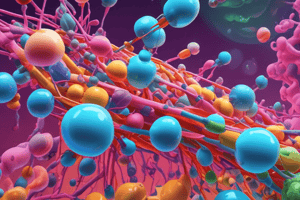Podcast
Questions and Answers
What is the primary use of bleomycin in cancer treatment?
What is the primary use of bleomycin in cancer treatment?
- Testicular cancers and Hodgkin lymphoma (correct)
- Colon cancer
- Lung cancer
- Breast cancer
Which enzyme plays a significant role in bleomycin metabolism?
Which enzyme plays a significant role in bleomycin metabolism?
- Dehydrogenase
- Hydrolase (correct)
- Oxidase
- Isomerase
How does bleomycin cause DNA damage?
How does bleomycin cause DNA damage?
- By binding directly to DNA without causing any damage
- By activating DNA repair mechanisms
- By attacking the phosphodiester bonds of DNA (correct)
- By preventing DNA replication
Which tissue has low levels of the bleomycin-inactivating enzyme?
Which tissue has low levels of the bleomycin-inactivating enzyme?
What is the most serious adverse effect associated with bleomycin?
What is the most serious adverse effect associated with bleomycin?
In what phase of the cell cycle does bleomycin cause cells to accumulate?
In what phase of the cell cycle does bleomycin cause cells to accumulate?
How do nitrosoureas exert their cytotoxic effects?
How do nitrosoureas exert their cytotoxic effects?
In which type of cells is the cytotoxicity of nitrosoureas primarily expressed?
In which type of cells is the cytotoxicity of nitrosoureas primarily expressed?
What is the major excretory route for nitrosoureas in the body?
What is the major excretory route for nitrosoureas in the body?
How is lomustine primarily administered?
How is lomustine primarily administered?
Which process inhibits several key enzymatic processes in targeted cells by carbamoylation of amino acids?
Which process inhibits several key enzymatic processes in targeted cells by carbamoylation of amino acids?
What is responsible for the alkylating activity of dacarbazine?
What is responsible for the alkylating activity of dacarbazine?
Which mechanism of action is induced by doxorubicin-derived free radicals?
Which mechanism of action is induced by doxorubicin-derived free radicals?
What is the major route of elimination for anthracycline antibiotics?
What is the major route of elimination for anthracycline antibiotics?
Why must anthracycline antibiotics be administered intravenously?
Why must anthracycline antibiotics be administered intravenously?
What adverse reaction is more common with daunorubicin and doxorubicin than with idarubicin and epirubicin?
What adverse reaction is more common with daunorubicin and doxorubicin than with idarubicin and epirubicin?
What is a serious problem that can occur due to extravasation of anthracycline antibiotics?
What is a serious problem that can occur due to extravasation of anthracycline antibiotics?
Why do veins surrounding the site of infusion become visible with anthracycline drugs?
Why do veins surrounding the site of infusion become visible with anthracycline drugs?
What is the cytotoxic step in the metabolism of cyclophosphamide and ifosfamide?
What is the cytotoxic step in the metabolism of cyclophosphamide and ifosfamide?
How is cyclophosphamide primarily excreted from the body?
How is cyclophosphamide primarily excreted from the body?
Which enzyme plays a significant role in the metabolism of ifosfamide?
Which enzyme plays a significant role in the metabolism of ifosfamide?
What is the main cause of bladder toxicity associated with cyclophosphamide and ifosfamide?
What is the main cause of bladder toxicity associated with cyclophosphamide and ifosfamide?
Which compound can help minimize the risk of hemorrhagic cystitis associated with cyclophosphamide and ifosfamide?
Which compound can help minimize the risk of hemorrhagic cystitis associated with cyclophosphamide and ifosfamide?
What is the reported cause of neurotoxicity in patients on high-dose ifosfamide?
What is the reported cause of neurotoxicity in patients on high-dose ifosfamide?
Which enzyme does temozolomide inhibit to prevent DNA repair?
Which enzyme does temozolomide inhibit to prevent DNA repair?
How does temozolomide differ from dacarbazine in terms of metabolic transformation?
How does temozolomide differ from dacarbazine in terms of metabolic transformation?
What is the active metabolite responsible for methylation of DNA by both dacarbazine and temozolomide?
What is the active metabolite responsible for methylation of DNA by both dacarbazine and temozolomide?
In what type of cancer does dacarbazine find use?
In what type of cancer does dacarbazine find use?
Which cancer type is temozolomide specifically used to treat due to its ability to cross the blood-brain barrier?
Which cancer type is temozolomide specifically used to treat due to its ability to cross the blood-brain barrier?
How is temozolomide administered for treatment?
How is temozolomide administered for treatment?
What is the primary route of elimination for Vinca alkaloids?
What is the primary route of elimination for Vinca alkaloids?
Which adverse effect is more commonly associated with Vinca alkaloids than with the taxanes?
Which adverse effect is more commonly associated with Vinca alkaloids than with the taxanes?
What is the main reason dosage adjustment is necessary for Vinca alkaloids in patients with liver impairment?
What is the main reason dosage adjustment is necessary for Vinca alkaloids in patients with liver impairment?
Which adverse reaction is a common effect of both Vinca alkaloids and taxanes if intrathecal administration occurs?
Which adverse reaction is a common effect of both Vinca alkaloids and taxanes if intrathecal administration occurs?
What effect do Vinca alkaloids have on cells that result from their interference with the spindle apparatus?
What effect do Vinca alkaloids have on cells that result from their interference with the spindle apparatus?
Which drug is more potent between Paclitaxel and docetaxel?
Which drug is more potent between Paclitaxel and docetaxel?
What is the primary cause of hyperuricemia associated with Vinca alkaloids?
What is the primary cause of hyperuricemia associated with Vinca alkaloids?
What is a significant safety precaution to prevent fatal outcomes when administering VX and VBL?
What is a significant safety precaution to prevent fatal outcomes when administering VX and VBL?
Which organ is primarily responsible for metabolizing Vinca alkaloids through the CYP450 pathway?
Which organ is primarily responsible for metabolizing Vinca alkaloids through the CYP450 pathway?
What is a common adverse effect associated specifically with Vinca alkaloids compared to other anti-cancer drugs?
What is a common adverse effect associated specifically with Vinca alkaloids compared to other anti-cancer drugs?
Study Notes
Anti-Cancer Agents
Dacarbazine and Temozolomide
- Dacarbazine is used to treat melanoma and Hodgkin lymphoma
- Must undergo biotransformation to an active metabolite, MTIC
- MTIC is responsible for alkylating DNA, leading to cytotoxicity
- Temozolomide is related to dacarbazine, but does not require CYP450 system for metabolic transformation
- Temozolomide crosses the blood-brain barrier, making it useful for brain tumors
- Administered intravenously or orally with excellent bioavailability
- Excreted in urine
Alkylating Agents
Cyclophosphamide and Ifosfamide
- Developed as vesicants during World War I
- Used to treat lymphatic cancers due to ability to cause lymphocytopenia
- Cyclophosphamide and ifosfamide are closely related mustard agents
- Used in combination with other agents to treat various lymphatic and solid cancers
- Can lead to secondary malignancies such as acute leukemia
- Mechanism of action involves biotransformation to hydroxylated intermediates in the liver
- Active compounds phosphoramide mustard and acrolein are formed
- Reaction of phosphoramide mustard with DNA is cytotoxic step
Pharmacokinetics
- Cyclophosphamide available in oral and IV preparations
- Ifosfamide is IV only
- Cyclophosphamide metabolized in liver to active and inactive metabolites
- Minimal amounts excreted in urine as unchanged drug
- Ifosfamide metabolized by CYP450 3A4 and 2B6 isoenzymes
- Mainly renally excreted
Adverse Effects
- Hemorrhagic cystitis due to acrolein in urine (cyclophosphamide) or toxic metabolites (ifosfamide)
- Adequate hydration and IV injection of mesna can minimize problem
- Neurotoxicity reported in patients on high-dose ifosfamide due to chloroacetaldehyde
Nitrosoureas
- Carmustine and lomustine are closely related nitrosoureas
- Used to treat brain tumors
- Mechanism of action involves alkylation of DNA, inhibition of replication and RNA and protein synthesis
- Carbamoylation of amino acids in proteins in targeted cells
- Nondividing cells can escape death if DNA repair occurs
Bleomycin
- Mixture of different copper-chelating glycopeptides
- Causes scission of DNA by oxidative process
- Cell cycle specific, causes cells to accumulate in G2 phase
- Used to treat testicular cancers and Hodgkin lymphoma
- Mechanism of action involves DNA-bleomycin-Fe2+ complex formation
- Liberated electrons react with oxygen to form superoxide or hydroxyl radicals
- Attacks phosphodiester bonds of DNA, resulting in strand breakage and chromosomal aberrations
Pharmacokinetics
- Administered by various routes
- Bleomycin-inactivating enzyme (hydrolase) is high in liver and spleen, low in lung, and absent in skin
- Most of parent drug excreted unchanged in urine, necessitating dose adjustment in patients with renal failure
Adverse Effects
- Pulmonary toxicity, progressing from rales, cough, and infiltrate to potentially fatal fibrosis
- Hypertrophic skin changes and hyperpigmentation of hands prevalent
- Myelosuppression rare
Studying That Suits You
Use AI to generate personalized quizzes and flashcards to suit your learning preferences.
Related Documents
Description
Explore the mechanisms of action and pharmacokinetics of doxorubicin and other anthracyclines in the treatment of acute leukemias and prostate cancer. Learn how these agents induce cytotoxicity through various mechanisms such as membrane lipid peroxidation and DNA strand scission.




